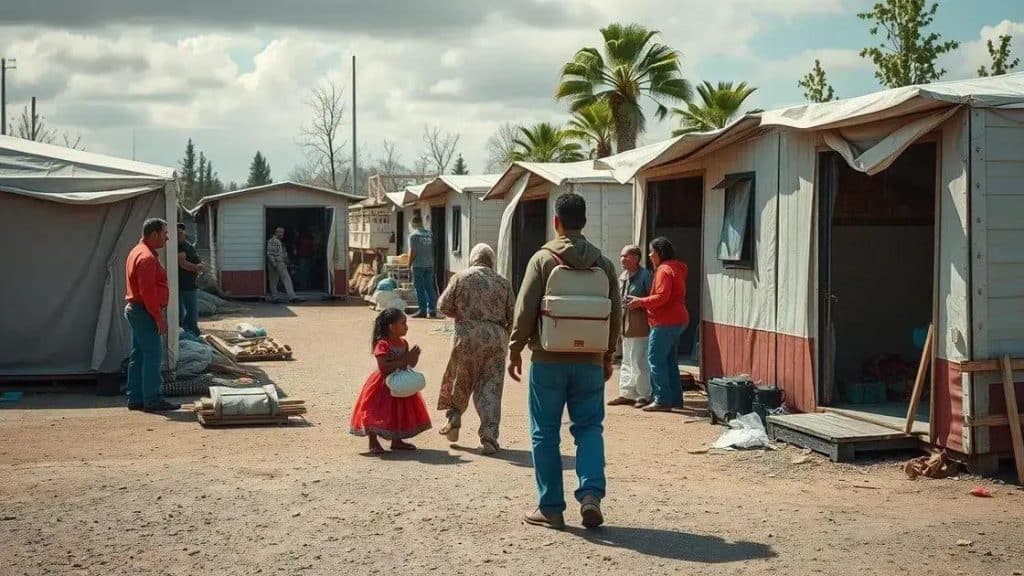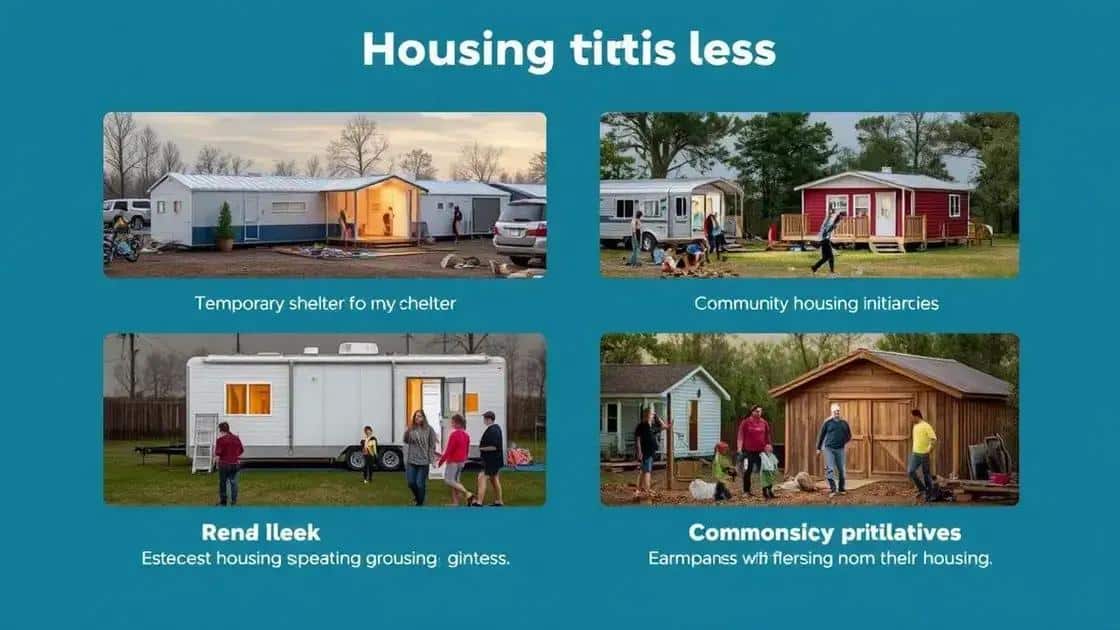Emergency housing support after natural disasters

Emergency housing support after natural disasters provides essential resources and assistance to displaced families, helping them regain stability and rebuild their lives while promoting community resilience and recovery.
Emergency housing support after natural disasters plays a vital role in community recovery. Have you ever thought about how this support shapes lives during crises? Let’s dive in and explore the impact of these resources.
Understanding the need for emergency housing support
Understanding the need for emergency housing support is crucial in the aftermath of a natural disaster. When families lose their homes, the immediate focus shifts to providing safe and stable shelter. This support is vital for recovery and rebuilding lives.
The Importance of Quick Response
Responding quickly to housing needs can drastically affect a community’s recovery. Immediate housing support helps families regain a sense of normalcy, which is essential for mental health and well-being.
- Access to basic necessities like food and water
- A sense of security during chaotic times
- Stabilizing the local economy
Providing emergency housing goes beyond just shelter; it lays the foundation for rebuilding communities. By ensuring that families have a place to stay, organizations can promote healing and recovery.
Types of Housing Solutions
Various types of solutions exist for emergency housing support. Temporary shelters, mobile homes, and even community centers can provide necessary housing resources. Each solution caters to different community needs and circumstances.
Innovative strategies are key. Organizations are now leveraging technology to streamline housing distribution. This helps to match families with available resources quickly and efficiently.
In addition, partnerships with local governments and nonprofits can enhance the effectiveness of emergency housing efforts. By working together, they can pool resources and provide comprehensive support to those affected.
Ultimately, understanding the need for emergency housing support is not just about providing shelter. It’s about fostering recovery and resilience in the face of adversity.
Types of emergency housing solutions

There are several types of emergency housing solutions designed to assist individuals and families after a natural disaster. Each type caters to different needs and circumstances, ensuring that help is accessible to everyone affected.
Temporary Shelters
Temporary shelters are crucial in the initial phase following a disaster. These facilities are often set up in community centers, schools, or large tents, providing immediate refuge. They offer essential services such as food and medical care.
- Quick set-up to accommodate displaced individuals
- Basic amenities for health and comfort
- Community support and networking
Although these shelters are temporary, they play a vital role in stabilizing communities during the crisis.
Mobile Homes and RVs
Mobile homes and recreational vehicles (RVs) serve as viable emergency housing solutions for families who need more long-term options. They are portable and allow families to stay close to their original neighborhoods while they rebuild.
These units often come equipped with kitchens and bathrooms, making them a practical choice for extended stays. Mobile homes can be set up quickly, allowing families to regain their independence.
Community Housing Initiatives
Community housing initiatives, often organized by local governments or nonprofits, provide a range of solutions. These can include building new homes or renovating existing buildings to create safe living spaces for those displaced.
This approach helps not only in providing shelter but also in enhancing the community by investing in its infrastructure. These projects can foster a sense of unity as neighbors collaborate to rebuild.
By understanding the various types of emergency housing solutions, communities can better prepare for swift recovery after natural disasters. Each solution plays a significant role in ensuring safety and stability for those in need.
How communities can access support
Understanding how communities can access support after a natural disaster is essential for effective recovery. Various resources are available, but accessing them can sometimes be challenging. Communities need to know where to look and how to navigate these resources efficiently.
Connecting with Local Organizations
One effective way for communities to access support is by connecting with local organizations and nonprofits. These groups often specialize in disaster recovery and can provide immediate assistance.
- Identify local shelters and food banks
- Reach out to local nonprofits for support services
- Collaborate with community centers for resources
Engaging with these organizations can streamline the process, helping families receive necessary aid quickly. They often have trained staff who can guide individuals through the available options.
Leveraging Government Resources
Government agencies play a significant role in providing support after disasters. Communities should stay informed about federal and state programs designed to assist residents in need.
Local housing authorities can offer guidance on available housing assistance programs. Furthermore, communities might qualify for federal disaster relief funds, which can significantly ease recovery efforts.
Community Awareness and Outreach
Awareness is key to accessing available support. Organizing community outreach programs can help inform residents about resources and services available to them. Distributing flyers or holding community meetings can raise awareness.
Engaging local leaders and volunteers in these efforts can enhance outreach. This way, information flows easily to those who need it most, ensuring that aid reaches every affected person.
Overall, understanding how communities can access support involves utilizing local resources, engaging with government assistance, and ensuring widespread awareness within the community. This multifaceted approach can greatly improve recovery outcomes.
Long-term effects of emergency housing assistance

The long-term effects of emergency housing assistance can dramatically shape the recovery trajectory for communities affected by disasters. While immediate relief is essential, the lasting impact often determines how families rebuild their lives.
Stabilizing Housing Conditions
One of the primary benefits of emergency housing assistance is the stabilization it provides. After a disaster, families may find themselves in precarious situations, living in temporary shelters or with no shelter at all. Emergency housing solutions help families transition back into stable living conditions.
- Reducing homelessness in the aftermath of disasters
- Enabling families to focus on recovery and rebuilding
- Promoting mental health by providing security and safety
This stabilization is crucial for both individual families and the community’s overall health.
Economic Recovery
Emergency housing assistance also plays a vital role in economic recovery. When families regain their homes, they can return to work and contribute to the local economy. As a result, communities can bounce back more quickly.
Many of these families face financial challenges due to loss of income during the disaster. By providing housing assistance, communities can help families manage these challenges while they rebuild their lives.
Community Resilience
Emergency housing assistance fosters community resilience, teaching populations how to prepare for and respond to future disasters. Programs that provide training and resources help families and neighborhoods become more equipped to handle emergencies.
Residents who participate in recovery initiatives often develop stronger social ties with their neighbors, creating networks that can support each other during future crises.
In conclusion, the long-term effects of emergency housing assistance are multifaceted. They not only stabilize housing but also promote economic recovery and enhance community resilience. These factors are essential in creating a robust framework for recovery that can withstand future challenges.
FAQ – Frequently Asked Questions about Emergency Housing Support
What is emergency housing support?
Emergency housing support refers to resources and assistance provided to individuals and families who have lost their homes due to natural disasters.
How can communities access emergency housing support?
Communities can access support through local organizations, government programs, and community outreach initiatives that provide resources and information.
What are the long-term benefits of emergency housing assistance?
Long-term benefits include stabilization of housing, economic recovery, and community resilience, helping families rebuild their lives effectively.
Why is community involvement important in recovery efforts?
Community involvement fosters stronger social ties, enhances awareness of available resources, and promotes collaboration in overcoming challenges after a disaster.





